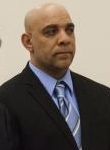 Carlos Davis (Photo by Kevin C. Downs for New York Daily News) Shortly after midnight on September 17, 1988, a shooting erupted near the corner of Cozine Avenue and Hendrix Street in East New York. Nineteen-year-old Norris Williams, the stepson of a New York police officer, was fatally shot in the chest.
About five hours later, New York police detective Louis Scarcella and his partner, acting on witness accounts, arrested 18-year-old Carlos Davis at his home several blocks away.
Davis was charged with second degree murder and criminal possession of a firearm. He went to trial in Kings County Supreme Court in March 1991. The sole witness to link him to the shooting of Williams was Christina Smith, who had emerged at the last minute.
Williams’ brother brought her to the prosecutors after other prosecution witnesses had failed to appear or had invoked their Fifth Amendment right against self-incrimination and refused to testify. Smith said she was near the area of the shooting talking on a pay phone when the shots were fired. She identified Davis as the person who shot Williams.
The defense called an investigator who testified that the distance from where Smith said she was standing to where Williams was shot measured 825 feet—which made it extremely unlikely she could identify the gunman.
Another witness testified that he was on the street at the time of the shooting and that Davis did not have a gun and did not fire any shots.
On March 5, 1991, the jury acquitted Davis of the murder charge, but convicted him of criminal possession of a weapon. The trial judge sentenced him to 7½ to 15 years in prison, plus an additional one to three years for violating his probation for an earlier robbery and assault conviction, to be served consecutively.
Davis appealed, but the Appellate Division of the New York Supreme Court upheld the conviction in March 1995. He was released from prison on parole on March 13, 1997.
In 2014, newly elected Brooklyn District Attorney Kenneth Thompson’s Conviction Review Unit began investigating about 70 convictions in which Scarcella had been involved. The review followed the exoneration of David Ranta, whose murder conviction was set aside after Scarcella was accused of severe misconduct. Among other items, he told one witness to pick Ranta in a lineup and allowed two other prosecution witnesses—both convicted felons—to leave jail, smoke crack and have sex with prostitutes in return for implicating Ranta.
At about the same time, The New York Times published an article accusing Scarcella of misconduct in many other investigations as well: fabricating evidence, coercing witnesses and concealing evidence of defendants’ innocence.
Scarcella’s involvement in the prosecution of Davis was minimal and he was not involved with the testimony of Christina Smith, but the Conviction Review Unit re-examined the case nonetheless. His misconduct played a part in 17 exonerations.
Investigators for the Conviction Review Unit tracked down Smith after they determined that she was actually named Kristie Hayes and that she had testified using a false name, false age and false address, as well as other false details.
When interviewed by the Conviction Review Unit, Hayes insisted that Davis was the gunman, but she gave an extremely inaccurate description of the gunman. In addition, Hayes’s account of how she came to be a witness at the last minute was not credible.
The Conviction Review Unit contacted Davis and informed him that based on their investigation, they no longer could support the conviction. On April 2, 2015, Davis’s lawyer, Francis Murray asked New York Supreme Court Justice Matthew D’Emic to vacate Davis’s conviction. The judge granted that motion and then granted the prosecution’s motion to dismiss the charge.
In July 2016, a federal civil rights lawsuit was filed on behalf of Davis against the city of New York. The lawsuit was settled for $750,000. |